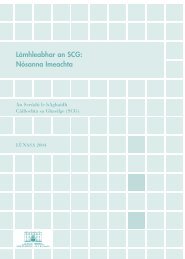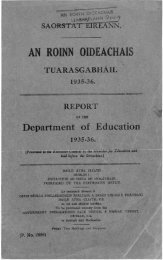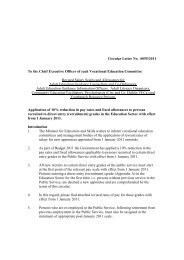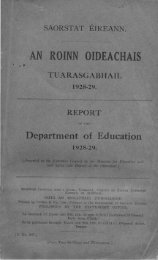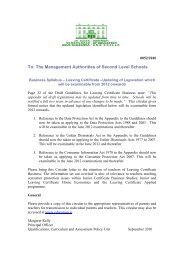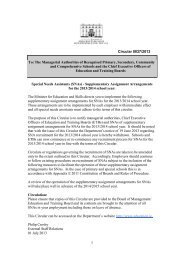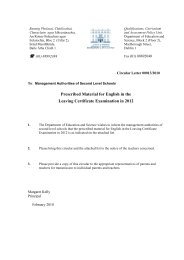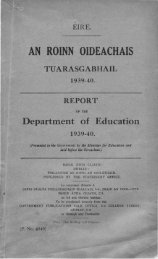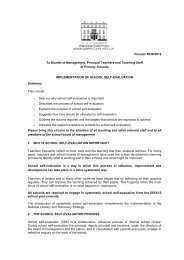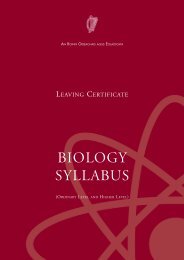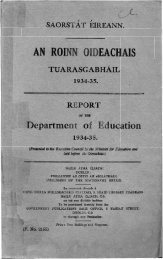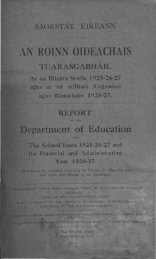1927-1928 - Department of Education and Skills
1927-1928 - Department of Education and Skills
1927-1928 - Department of Education and Skills
You also want an ePaper? Increase the reach of your titles
YUMPU automatically turns print PDFs into web optimized ePapers that Google loves.
24<br />
<strong>of</strong> the School Attendance Act a good many schools have<br />
become ov~r~ro~ded. The managers are, however, showinz increased<br />
activity m taking steps to remedy these defects. '"<br />
,!,~e~e arc schools in every District <strong>of</strong> the Division as a rule<br />
adJomm~ schools under the same ro<strong>of</strong>, which might be amalga-<br />
~at~d with consequent improved staffing, leading to fewer classes<br />
m c. arge <strong>of</strong> one teacher. Amalgamation in these cases would be<br />
Pos~Ible,. <strong>and</strong> even though there were no immediate monetary<br />
£avI~g, mcreased efficiency for the same expenditure could be<br />
obtained,<br />
It is regre,ttable that many <strong>of</strong> the older schoolhouses were badly'<br />
planned. 'I'hey are generally <strong>of</strong> two kinds: (1) With one laro-e'<br />
room <strong>and</strong> a classroom, the latter usually with a gallery <strong>and</strong> norm~lly<br />
ov.ercrowde~; ~2) 'With one room for two or more teachers"<br />
this lea.d~ng to defectIve organisation <strong>and</strong> waste <strong>of</strong> teaching power<br />
In addItIn" fireplaces .an~ windows are <strong>of</strong>ten <strong>of</strong> inferior type, s~<br />
that heating <strong>and</strong> ventilation are defective. It should be added<br />
owever, that the modern types <strong>of</strong> schoolhouses are sat1sfactor;<br />
m all these respects.<br />
. As a general rule the cleanliness <strong>and</strong> decoration <strong>of</strong> the schools<br />
leave mU:h .to e desired. The floo~'S are seldom washed; in many<br />
cases thel.e IS lIttle attempt at dusting <strong>and</strong> brightening the rooms<br />
<strong>and</strong> keeping them neat <strong>and</strong> attractive; out-<strong>of</strong>fices are neglected,<br />
<strong>and</strong> are frequ~ntly. almost un~t for use; exterior school premises.<br />
~s a. rule receive little attention, much less in general than the,<br />
mteriors.<br />
'I'aking the Division as a whole, a. fair number <strong>of</strong> schools are<br />
not provided with playgrounds <strong>and</strong> latrines.<br />
A very marked improvement in regularity <strong>of</strong> attendance can be<br />
recorde.d. The percentage <strong>of</strong> attendance for the Division is now<br />
approxImately SO-an increase <strong>of</strong> 10 points or so. The recent Act<br />
has undoub~edly proved beneficial in this respect. On the other<br />
h<strong>and</strong>, the~e IS a tendency' amongst parents to keep the children at<br />
home until they reach the age <strong>of</strong> six years <strong>and</strong> to take them from<br />
school as soon as they reach the age <strong>of</strong> fourteen. It is still<br />
unfortun~tely, true that there is a good deal <strong>of</strong> unpunctuality i~<br />
the mornmg attendance <strong>of</strong> the pupils.<br />
'With greater regularity <strong>of</strong> attendance more expeditious <strong>and</strong><br />
steady progress ~hrough the st<strong>and</strong>ards has been found possible.<br />
Pr~motIOn from infant classes is more rapid than formerly. The<br />
senior st<strong>and</strong>ards are <strong>of</strong>ten but thinly represented. This would<br />
appe~r to be due in part to a misinterpretation <strong>of</strong> the Attendance<br />
~ct, m part to the fact that the older children are kept at home,<br />
m order t~at the youngcr ones may be sent to school more regu-<br />
]ar~y, <strong>and</strong> m part to the want <strong>of</strong> an incentive to remain at school.<br />
It I~ to b~ hoped that the creation <strong>of</strong> a Leaving Certificate may<br />
pro, e an mduccment to many to remain longer.<br />
25<br />
'While no material change in general pr<strong>of</strong>iciency is to be noted,<br />
the tendency is towards improvement. The subjects in which<br />
least progress is being made are Composition in both Irish <strong>and</strong><br />
English, <strong>and</strong> History. As regards the latter, there is evidence <strong>of</strong><br />
increased effort to deal with local history, but to many teachers.<br />
the lack <strong>of</strong> printed materials <strong>and</strong> texts proves a formidable<br />
obstacle.<br />
From the statistics available it is possible to say little as yet in<br />
the matter <strong>of</strong> the progress made in Rural Science <strong>and</strong> Nature<br />
Study. Though reluctance was shown at first in introducing<br />
these branches, they are now being generally taken up where<br />
conditions dem<strong>and</strong> it; <strong>and</strong> there are signs that progress in them<br />
henceforth will be steady <strong>and</strong> improving.<br />
About 60 per cent. <strong>of</strong> the teachers in this Division have by this<br />
time secured certificates in Irish; the great majority holding the<br />
ordinary certificate. From 35 to 40 per cent. are still uncertificated,<br />
but among these are many elderly teachers who will<br />
never secure certificates.<br />
Though the teachers' qualifications are now higher than at any<br />
former time, there has not been, generally speaking, a corresponding<br />
advance in dealing with the language, nor has there been a<br />
corresponding extension in the use <strong>of</strong> Irish in the school work as<br />
a whole. The area covered by this Division being almost entirely<br />
English-speaking, there appears to be, as a rule, little real<br />
enthusiasm in the language cause; <strong>and</strong> the consequence is that<br />
the language teaching in the schools is not producing speakers.<br />
Many <strong>of</strong> the senior pupils in well-taught schools know a great<br />
deal <strong>of</strong> Irish, but in very few cases do they speak it in school, <strong>and</strong><br />
in fewer still outside school.<br />
Defective methods <strong>of</strong> teaching Irish are still too common; the<br />
written side <strong>of</strong> the language, on the whole, suffering more from<br />
this cause than the oral side. Moreover, the middle-aged <strong>and</strong><br />
older teachers, who took up the study <strong>of</strong> the language some six<br />
years ago, seem to have reached the limits <strong>of</strong> their possible<br />
progress; <strong>and</strong> they are not in truth turning out good speakers <strong>of</strong><br />
Irish from the schools. Lack <strong>of</strong> confidence in themselves <strong>and</strong><br />
want <strong>of</strong> fluency in speech drive them to dependence on the book<br />
as the main factor in teaching, When we have in the schools a<br />
considerable proportion <strong>of</strong> teachers at present in training these<br />
conditions will be entirely changed <strong>and</strong> a big forward movement<br />
will be possible, In the meantime, progress will be only gradual.<br />
As regards the general work <strong>of</strong> the teachers, it is on the whole<br />
distinctly satisfactory throughout the Division, in which the great<br />
majority rank as either highly efficient or efficient. The approximate<br />
figures are-highly efficient, 17%; efficient, 77%; while<br />
only 6% arc rated non-efflcient.



